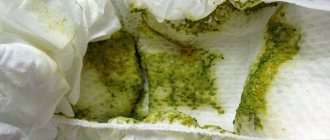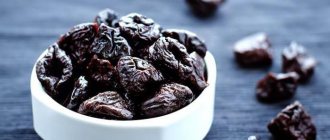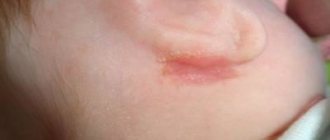What should a baby's stool look like normally?
Immediately after birth, young mothers notice a viscous and sticky dark green, almost black mass on the baby’s diaper, which causes panic. Do not worry, this color of stool in a newborn baby is normal. The baby's first stool resembles tar or machine oil; it is called meconium. It contains what the baby ate in the womb.
With regular breastfeeding, the dark green color of the baby's stool will change to light green. This will happen when colostrum replaces full breast milk, in about 2-3 days. The norm for a baby from 1 to 12 months is considered to be yellow or mustard-colored feces with a sour odor, without mucus, blood, or lumps.
Sometimes dark green feces may be observed in infants, but there should be no strong unpleasant odor. If other unpleasant symptoms are present, you should be wary and find out the cause of this phenomenon.
You should immediately make an appointment with a pediatrician if your baby has:
- sleep is disturbed;
- vomiting appeared;
- the temperature has risen;
- I lost my appetite.
What should a normal stool look like?
At different stages of development, the baby's stool changes from a liquid, unnatural color to a fraction characteristic of each person. Parents must be sure to monitor the frequency, consistency, color and presence of odor in the child’s discharge.
First three days of life
During this period of a little person’s life, the accumulation of remnants of amniotic fluid that entered the body at birth, intestinal epithelial cells, bile, mucus, etc. occurs in his intestines. Such feces are called original feces or meconium.
The discharge has a black, dark red or olive tone, a resinous structure and is odorless. Green stool in a newborn is not due to the bacterial nature of its formation. The appearance of discharge is the first sign of normal functioning of the gastrointestinal tract.
During the first two to three days, a breastfed baby’s body completely absorbs the mother’s colostrum, so feces are not formed.
Fourth – sixth days
The baby's intestinal system is developing due to changes in the composition of the nursing mother's milk and the formation of bacteria in the digestive tract.
The process occurs in two stages:
- Transitional feces
The baby's stool has the appearance of a paste, thick sour cream, the color is predominantly yellowish, with rare splashes of green (residual effects of meconium). The presence of a white mass and small amounts of stool with mucus in an infant is not a deviation. Changes in the appearance of feces occur under the influence of bacteria in the gastrointestinal tract.
- Mature feces
The discharge takes on a dark green color with a transitional gray tint, and has a porridge-like consistency. Initially, the frequency of bowel movements is about ten times a day, and as you get used to breast milk, the frequency of bowel movements decreases to one or two times over three to seven days.
This is due to the complete absorption of the beneficial substances of breast milk in the infant’s gastrointestinal tract. It is necessary to strictly monitor meconium in the stool: if its presence in the stool is observed on the fifth day, you should consult a doctor. Artificial feeding can affect the structure of stool.
Second week of life – 28 days
The baby's stool takes on a light brown, mustard color. The consistency of the mass is mushy. Green, liquid stool in a baby or constipation indicate the occurrence of abnormalities.
First months
At the stage of feeding the baby with breast milk, the stool is normally mature. The waste products of a baby can be light brown, grayish and even green. The feces of a month-old baby on breastfeeding should be of medium density: neither liquid nor solid.
At 3 years of age, the presence of food inclusions in the stool is allowed, and the color directly depends on the food the child eats.
Why does my baby have dark green stool?
A mother who cares about the health of her child should pay attention to all additional factors that accompany the appearance of green stool. To distinguish normality from pathology, it is important to consider the following points:
- consistency of stool;
- inclusions and impurities in feces;
- presence of additional symptoms;
- child's age.
Green stool with mucus
Dark green mucus in a baby's stool may be normal, but if the baby is feeling excellent, he is cheerful and does not cry, eats with appetite and gains weight. Green stool with mucus in the absence of fever may be a sign of dysbacteriosis. Modern pediatricians do not consider this a disease, and therefore treatment is not required.
The reason is that the baby’s digestive system needs time to adapt to new conditions and nutrition. Immediately after birth, the intestines are colonized with permanent microflora, and dark green liquid stools with mucus may be observed in the infant.
The formation of healthy microflora in a newborn baby is ensured by:
- early attachment of the baby to the breast;
- natural feeding, which lasts at least six months;
- excluding the use of antibacterial drugs (as far as possible) by both the young mother and the baby.
If there are a lot of mucous inclusions, and the baby behaves restlessly, then this condition can be provoked by:
- indigestion;
- dysentery;
- Mom's food poisoning.
What should parents do?
The smartest decision for every parent would be to go to the doctor. If a child has a fever and severe diarrhea, then urgently call an ambulance, which will take you and the baby to a specialized medical facility.
You should not refuse hospitalization. In the hospital, the child will be provided with qualified first aid and tests will be taken to determine the cause of the severe symptoms.
In the absence of fever and pronounced symptoms, the child should be shown to a pediatrician.
The specialist will order the necessary tests, which will give a complete picture of his health:
| Analysis | What does it reveal? |
| Scatology | Determines the factors of a disturbed gastrointestinal tract, identifies various types of infections. |
| Bakposev | Helps to obtain a characteristic of the general condition of the intestinal microflora. |
| Urine and blood analysis | Deviation from the norm indicates a specific disease. |
Thanks to diagnosis, the doctor will be able to prescribe effective treatment for the baby.
Often, to normalize the functioning of the gastrointestinal tract, infants are prescribed dietary supplements (biological food additives) with probiotics and prebiotics (Linox, Acipol, Lactobacterin), which favor the proliferation of beneficial bacteria in the body.
Liquid green stool in a baby
The consistency of baby's stool is also not always the same, it may depend on:
- nutrition of a young mother;
- composition of the infant's intestinal microflora;
- introducing complementary foods, feeding the baby;
- hormonal background of a woman.
Dark green feces in a baby with a liquid consistency may appear as a result of excess iron entering the baby's body from formula or mother's milk.
Other reasons for this phenomenon:
- oxidation of feces upon contact with air;
- leafy vegetables that are given to the child as complementary foods;
- changes in intestinal microflora;
- baby teething;
- consumption of foods that can irritate feces by a nursing mother (zucchini, broccoli and cucumbers).
Serious causes of green stool
The appearance of green stool in a baby can pose a great threat to his health and indicate the presence of a number of pathological changes in the body:
- dysbacteriosis;
- fungal infections, rotaviruses, enteroviruses;
- congenital disorders of the digestive system;
- weakened immune system;
- lactose deficiency;
- allergic reaction to the mixture or its individual components;
- enterocolitis.
After analyzing the presence of symptoms in a child, you should immediately decide on his treatment. However, only a pediatrician can prescribe adequate and effective therapy.
Hard green stool
Constipation in a baby who is fed mother's milk is a rare occurrence. Most often, this problem occurs in artificial babies. Hard, dark green stool in a formula-fed baby is a reason to pay attention to its nutrition. It is advisable to consult a pediatrician; perhaps he will recommend changing the formula.
Feces with such characteristics may appear after taking antibacterial drugs. The reason is changes in the composition of the intestinal microflora under the influence of such drugs. This problem can arise even if the drugs were taken not by the child, but by the nursing mother. Other means can cause a similar violation:
- antifungal;
- hormonal;
- anti-inflammatory;
- astringents.
Malnutrition can also affect the color of stool. This most often happens if several feedings are replaced with formula milk. Lack of breast milk can affect the color of stools, making them appear green.
Chair color
Norm
Normal baby's stool may be yellow, orange, green or brown!
Peculiarities
- The first 2-3 days of life, the color of the original stool, or meconium, is black-green (due to the large amount of bilirubin, also in meconium, intestinal epithelial cells, amniotic fluid, mucus).
- On the 3rd day, the stool is called transitional, it contains the remains of meconium, but it is already larger in volume and lighter.
- Then the color of the stool of breastfed children becomes yellow-orange, and of bottle-fed children yellow-green.
- At 4-6 months, various changes in stool color when vegetables and then fruits are introduced into the baby’s diet
Mothers are very often concerned about the sudden appearance of green stool in both breastfed and bottle-fed babies. With such sudden changes, you need to understand whether the child’s condition has changed, whether there are any complaints or whether he is calm, has a good appetite and is gaining weight well. After all, weight is a very sensitive indicator of the health of such a small child!
Our baby is calm, his appetite is preserved, and he is gaining weight.
Any change in diet changes the color of the stool. This happens if you:
- Changed the formula (refrain from changing the formula frequently, this is a big blow to digestion) - if your child tolerates this formula well and grows, just “grow” with it.
- Enter anyone! complementary foods, although the brightest colors come from fruits and vegetables in your baby’s diet. The color of the stool in this case depends on the color of the complementary foods - green stool when taking green vegetables (broccoli, peas and green beans), red when taking carotene-rich fruits and vegetables (carrots, pumpkin, peach, apricot), beets give a pink-burgundy tint stool, do not introduce it into the diet too early (before 10 months). There is a relationship between the color of the stool and the diet of a nursing mother, which is maximum when there is a large amount of fruits and vegetables. Therefore, do not panic when you see the green or red contents of the diaper, if there is no mucus or blood, but remember what new has appeared in your baby’s diet over the past day or what culinary experiment you embarked on yesterday.
- You give your child medicine (or the mother breastfeeds and takes medicine herself)
- Taking some medications changes the color of the stool: black color is associated with taking iron supplements and carbon sorbents; taking antibiotics (even by a nursing mother) often changes both the color of the stool (more green) and its consistency (more liquid).
If there are no other abnormalities besides the greenish color, then you have nothing to worry about.
The child's condition has changed: there is vomiting, no appetite, the stool is loose, contains mucus or even blood, the baby is quickly losing weight.
These are signs of an intestinal infection, its course is dangerous at this age, you should immediately consult a doctor!
Alarming symptoms, you should immediately contact your pediatrician!
- The stool of a child in the first month of life is white or very light (the color of “white clay”) - this color of stool, especially in combination with increasing jaundice and dark urine, may indicate a narrowing or underdevelopment of the bile ducts inside the liver, most often of a congenital nature. In this case, urgent consultation with a pediatrician, surgeon and additional examination are necessary. If an apparently healthy, previously older child develops similar symptoms, liver disease is likely, which is also a reason to immediately consult a doctor.
Chair with green foam
There is no need to panic if you notice bubbles in your baby's stool, but you should take care to ensure that your baby is latched onto the breast correctly. Milk from the front part of the mammary glands will quench thirst and make the baby feel full. It has a thin and watery consistency. And hindmilk, which is fattier and more viscous, contains many of the nutrients a baby needs.
The appearance of a green tint in the stool may be a sign that the baby is receiving only foremilk, and this can lead to slow weight gain for the baby.
Proper breastfeeding will help correct the situation:
- the breast should be placed in the baby’s wide-open mouth;
- it is important to ensure that the baby grasps not only the nipple, but also the areola;
- the tip of the baby's nose should touch the mammary gland;
- You cannot transfer the baby from one breast to the other during one feeding;
- A nursing mother should not experience pain.
Also, do not limit the time the baby spends at the breast. For one person, a quarter of an hour is enough to satiate; weaker babies require long-term feeding.
A baby's stool that is dark green in color with foam can also be a sign of lactase deficiency, which can be either acquired or congenital. Pathology occurs when there is a deficiency or absence of an enzyme that breaks down milk sugar.
Green stool while breastfeeding
- Most often, the stool of a baby fed exclusively on breast milk is light brown in color, liquid in consistency with small white speckles, and has a sour odor. However, it is quite acceptable if the mother finds particles of mucus or streaks of blood in the diaper (due to a burst vessel in the intestine). Sometimes a newborn's stool may be foamy or green in color. There may be greenery for various reasons:
- If your baby pooped a while ago, the green color of the stool may be the result of an oxidation reaction in the air.
- The green color of baby's stool is given by certain foods that the mother may have eaten. Most often, vegetables are seen in this: cucumbers, zucchini (see the article vegetables for breastfeeding).
- Sometimes a green tint occurs due to certain medications. Iron itself gives stool a green color; antibiotics can disrupt the intestinal microflora, and as a result, it becomes green.
- Dysbacteriosis. This condition is not a disease; its essence lies in the name itself. Dysbacteriosis is an unbalanced composition of the intestinal flora. Bacteria, which ideally should be small, exceed the required amount. In children who are fully breastfed, dysbiosis can occur even from supplementary feeding, since the boiled water that is usually given to babies already upsets the natural balance in the intestines. In general, the imperfect composition of the intestinal flora is typical for infants, because their intestines are still in the process of formation. (See detailed article about dysbiosis >>>)
- Green, foamy stools are often mistaken for lactose intolerance. However, this diagnosis is quite rare. Most often, the problem is an imbalance of foremilk and hindmilk. We already know that because Foremilk is thinner and waterier, while hind milk is fattier, thicker and rich in nutrients. If the mother changes breasts too often or takes the breast away from the baby before he has finished suckling, the baby may not receive enough hindmilk, but receives foremilk in excess. In addition to green, foamy stools, in this case there is also poor weight gain.
- Due to the release of bilirubin.
Baby has dark green stool with blood: reasons
Red spots in a child's stool may be normal. The capillaries of the intestinal mucosa are still thin and brittle; when the baby strains, they can be damaged, which leads to the appearance of stool streaked with blood.
But if there are a lot of such impurities, this may indicate the presence of infections, internal damage to the intestines, congenital anomalies of the digestive system, acute inflammatory process, especially if the color of the stool is green and there is a strong unpleasant odor.
Green stools with other associated symptoms
Green stool accompanied by vomiting is a dangerous symptom. This is how intestinal infections caused by bacteria, fungi or viruses manifest themselves.
If the appearance of stool of an unusual color is accompanied by fever and fever, this may indicate severe poisoning. Also, the disorder can be caused by intestinal infection, viruses, helminthic infestation, and inflammatory processes in the gastrointestinal tract.
How to treat a child if he has green stool?
Treatment for a formula-fed baby who develops green stools depends on the cause of this phenomenon. Often, greenish, liquefied stools are caused by dysbacteriosis. To eliminate the consequences of an insufficient number of beneficial bacteria in the intestines, doctors prescribe the drugs Linex, Hilak Forte, Bifiform Baby, Bifidumbacterin and others to children.
For symptoms of diarrhea, you may need drugs Smecta, Enterosgel, Activated carbon. You cannot prescribe treatment for a child on your own; this is a matter for a specialist, because a small patient needs to calculate the correct dose of the drug, depending on the root cause of diarrhea. Intestinal infections are treated with antibiotics, but the young mother herself is not able to choose the right one. Therefore, after diagnosis, the doctor will select the optimal treatment regimen.
What should parents do when green stool appears?
If the baby’s health is normal, he is cheerful and cheerful, there is no vomiting or other suspicious signs, and the thermometer readings do not cause concern, then there is no need to worry.
If the child is lethargic and capricious, or there are other negative manifestations, it is necessary to determine the cause of the disorder. In this case, you will need the help of a pediatrician. The most dangerous symptoms that require mandatory consultation with a doctor are vomiting and diarrhea. Without timely intervention, such conditions can lead to severe dehydration.
The following conditions should also alert you:
- insufficient weight gain;
- skin rash;
- regurgitation or vomiting;
- heat;
- green, watery stools that last more than one day;
- prolonged loose stools of unusual color;
- feces in a newborn that leaves greasy marks on the diapers (if this is observed for 12 days or more, the baby may have intestinal problems);
- a large amount of blood impurities.
Before examining the pediatrician, provide your baby with proper care:
- apply to the breast more often;
- do a light massage, place it on your tummy;
- if necessary, use a children's antipyretic in the form of a rectal suppository.
Causes and signs of pathologies
Liquid green stool in a baby can frighten parents. It most often occurs in babies if they are bottle-fed. During the first week of life, a child develops a special type of stool – meconium. This original excrement has a greenish tint, which is considered quite normal. Along with it, particles of amniotic fluid and epithelial tissue are excreted.
In a baby, green stool after a week of life can signal to parents that there are serious abnormalities:
- foam and unpleasant odor occur in case of lactase deficiency. The pathology is dangerous as it causes a state of severe toxicosis in the newborn. The only way to get rid of it is to completely exclude whole milk from your diet;
- Foamy liquid green stool in an infant is a constant sign of staphylococcal enterocolitis. The disease is serious and requires immediate medical attention;
- vomiting and diarrhea are dangerous for the child. The green color of stool in this case signals the progression of rotavirus infection. Only a doctor can make a final diagnosis based on a detailed examination. He also selects a course of treatment to eliminate the pathology;
- green stool with black segments is a clear sign of disturbances in the gastrointestinal tract. You cannot hesitate to contact a specialist, because the situation of a small patient will only get worse.
- dark green stool in an infant with grains of blood is an alarming symptom if accompanied by profuse vomiting. Quite often this situation occurs immediately after feeding. Additionally, mommy will be able to detect rumbling sounds in her tummy and profuse rashes on the skin. As a rule, such a clinical picture manifests itself in a child in case of dysbacteriosis.
What should I do if the green color is due to high iron content in the stool?
Parents are advised to carefully monitor the health of their little patient. If there are no additional complaints, then you should not panic either. However, it is imperative to tell your pediatrician about this situation. He will be able to select an artificial mixture that will not cause such a negative reaction in the digestive system.
Even a three-month-old baby can find mucus in the stool. This manifestation indicates the immaturity of the gastrointestinal tract. The body does not yet have enough enzymes that are necessary for high-quality digestion of food. From time to time, you can observe the child's green stool containing various undigested pieces of food. This situation is also considered quite normal during the period of introducing complementary foods. After a certain period of time, the internal organs will be able to properly digest the food ingested.
Diagnostics
If there is green stool in combination with other unpleasant symptoms, the baby will undergo standard tests. In addition, scatology is recommended. The study examines the physical and chemical properties of feces. This diagnostic method will help determine the cause of the change in its color.
If necessary, a dysbacteriosis test is prescribed. This will allow you to assess the composition of the intestinal microflora and detect violations. If there is a problem, the specialist will recommend a diet and prescribe medications that restore the balance of microflora.
If inflammatory processes in the intestines are suspected, flora culture and bacteriological analysis will be recommended. After diagnostic tests, the doctor will prescribe a course of therapy, if necessary.
Preventing the problem from occurring
Knowing why a baby's stool may turn green, you can try to prevent this problem. A nursing mother should monitor her diet, eating only approved foods, while monitoring the baby's reaction and avoiding overeating. It is useful to take special nutritional supplements for women who are breastfeeding. Take care of proper breastfeeding: the baby should receive both fore and hind milk.
Regardless of the reason for the appearance of dark green stool in a child, you should not self-medicate. To understand why the disorder occurred, you need to consult a specialist, especially if the baby’s well-being is impaired. Only a pediatrician, after a thorough examination, will be able to give useful recommendations or prescribe the necessary medications.










